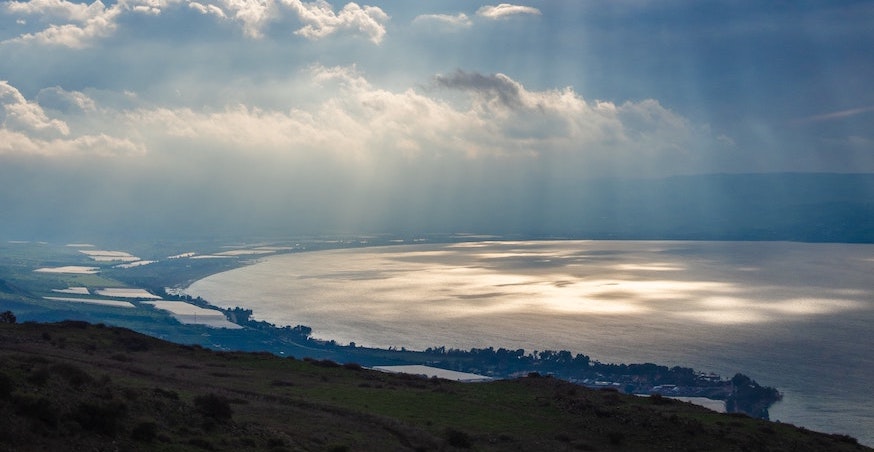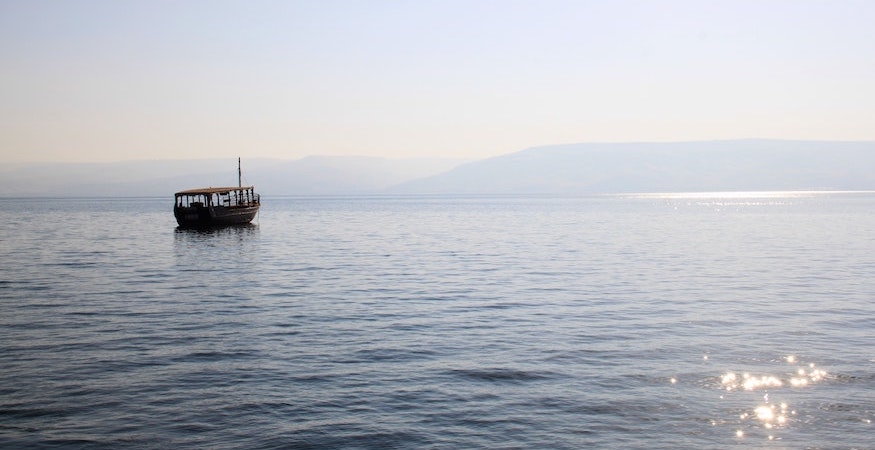The most famous Body of Water in the World
It is not the biggest in the world – though it has impressive dimensions.
It is not the most scenic – though it is picturesque and moving.
The number of fish it contains cannot rival that of many other bodies of water, yet its fish are world-famous.
Despite all this, it is the most famous body of water in the world.
Though it is a lake, we call it the ‘Sea of Galilee.’
A Bible tour of the holy land is not complete without a visit to this majestic, natural tribute to the ministry of Jesus Christ.
While called ‘Sea of Galilee’ five times in the New Testament (Matthew 4:18; 15:29; Mark 1:16; 7:31; John 6:31), it is also known as ‘Sea of Chinnereth (Numbers 34:11); Sea of Chinneroth (Joshua 12:3), and Sea of Tiberias (John 21:1). It’s Hebrew name is Kinneret, derived from the Hebrew word ‘kinnor’ which means ‘harp.’ Look at the lake on a map, and you’ll understand why.
“The Sea of Galilee is a fish-filled, freshwater lake in the arid Middle East – indeed, the only one. That alone makes the Sea of Galilee special”
Its dimensions? The Sea of Galilee is 21 kilometres (13 miles long), 10 kilometres (6.2 miles) wide, 50 metres (164 feet) deep, 51 kilometres (32 miles) around the shore, 166 square kilometres surface (64 square miles) and 224 meters (734 feet) below sea level. Its fish content includes catfish and tilapia.
While these dimensions may not impress compared to North America’s Great Lakes or Siberia’s Lake Baikal, the fact is its a fish-filled, freshwater lake in the arid Middle East – indeed, the only one. That alone makes the Sea of Galilee special.
And there is more. The reason this lake is the most famous in the world, drawing hundreds of thousands of Christian pilgrims year-after-year, is because it was the stage for Jesus Christ’s ministry, particularly the North and North-Western shore. Though born in Bethlehem of Judea, Jesus was raised a Galilean in Nazareth. After commencing His ministry, He was rejected by the people of Nazareth and moved His headquarters to Capernaum on the northern shore of the lake. This move was a fulfilment of prophecy (Matthew 4:12-17).
In Jesus’ day, there were up to seven cities on or near the lake, many with a population of 15,000 or more. These included Tiberias, Magdala, Gennesaret, Capernaum, Chorazin, Bethsaida, and Hippos. Despite its long coastline, Jesus basically ministered in the NW shoreline of the lake, from Magdala to Bethsaida.
The ultra-fertile Plain of Gennesaret, between Magdala and the Mount of Beatitudes, would have been very familiar to Him. It is subtropical, meaning, you can grow almost anything on it. This plain also was the location of the great Afro-Eurasian Highway, linking Africa with Asia and Europe. Jesus once visited the Gentile-inhabited, swine-herding, eastern shore of the lake to heal the man filled with a legion of demons. We now call this man the ‘Gadarene demoniac.’ Despite its proximity, it is possible Jesus never visited Tiberias, both because of its founder (Herod Antipas) and its unsavoury reputation and lifestyle.
“Even though twenty centuries have passed since the earthly ministry of Christ, a visit to the lake makes it feel as if time has stood still”
Consider the myriad of ministry activities that occurred near or on the Sea of Galilee, including:
- Luke 5:4-9: Catching a big haul of fish;
- Matthew 4:18-19: Disciples are called to follow Christ;
- Matthew 5-7: Sermon on the Mount, the most famous message in history;
- Mark 1:23-28: The Gadarene demoniac
- Matthew 8:14-15: Peter’s mother-in-law healed.
- Matthew 11:20-24: Cities of Capernaum, Chorazin, and Bethsaida rebuked.
- Mark 4:35-36: The Gadarene voyage;
- Luke 8:23-25: The stilling of the storm on the Lake;
- Mark 5:1-20: Gadarene demoniac healed;
- Matthew 14:13-21; Mark 6:i30-44; Luke 9:11-17; John 6:1-14: The feeding of the 5,000 (the only miracle of Jesus mentioned in all four gospels).
- Mark 6:45-52: Jesus walks on water;
- Matthew 15:32-38: Feeding of the 4,000;
- Mark 8:22-26: Blind man healed at Bethsaida.
Even though twenty centuries have passed since the earthly ministry of Christ, a visit to the lake makes it feel as if time has stood still: the glittering water, the mauve hills, the serene atmosphere, the strangely familiar surroundings, all lend themselves to a moving experience as you recall these Biblical events on-site.

Which kind of person am I? One like the Dead Sea? Or like the Sea of Galilee? | Photo: Yoav Aziz-lbjIl Unsplash
Finally, there is a spiritual lesson to be learned. The Sea of Galilee is fed by the Jordan River which sluggishly flows through the Great Rift Valley. One hundred kilometres to the south is a bigger but vastly different lake. In the southern lake, there are no fish, no freshwater, no thriving communities, no sound of birds singing or children playing, no grand holiday homes.
Here is the puzzle: both lakes are in the same country, same Great Rift Valley, and fed by the same Jordan River. So how can they be so different?
The answer is disarmingly simple: for every drop of the Jordan that flows into the Sea of Galilee, another drop flows out. Yet for the other lake, for every drop of the Jordan it receives, it keeps. That’s why it is called Dead.
Consider this great paradox between the two lakes and then ask yourself. Which kind of person am I? One like the Dead Sea? Or like the Sea of Galilee? Follow the latter and live.






